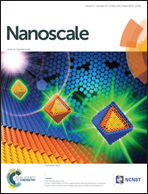Cubic PdNP-based air-breathing cathodes integrated in glucose hybrid biofuel cells†
Abstract
Cubic Pd nanoparticles (PdNPs) were synthesized using ascorbic acid as a reducing agent and were evaluated for the catalytic oxygen reduction reaction. PdNPs were confined with multiwalled carbon nanotube (MWCNT) dispersions to form black suspensions and these inks were dropcast onto glassy carbon electrodes. Different nanoparticle sizes were synthesized and investigated upon oxygen reduction capacities (onset potential and electrocatalytic current densities) under O2 saturated conditions at varying pH values. Strong evidence of O2 diffusion limitation was demonstrated. In order to overcome oxygen concentration and diffusion limitations in solution, we used a gas diffusion layer to create a PdNP-based air-breathing cathode, which delivered −1.5 mA cm−2 at 0.0 V with an onset potential of 0.4 V. This air-breathing cathode was combined with a specially designed phenanthrolinequinone/glucose dehydrogenase-based anode to form a complete glucose/O2 hybrid bio-fuel cell providing an open circuit voltage of 0.554 V and delivering a maximal power output of 184 ± 21 μW cm−2 at 0.19 V and pH 7.0.


 Please wait while we load your content...
Please wait while we load your content...